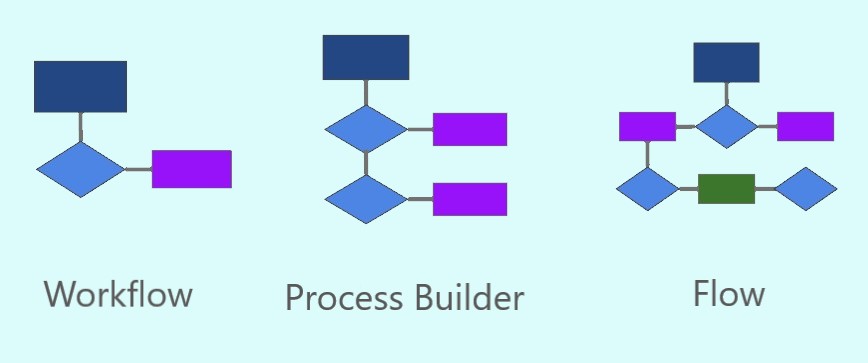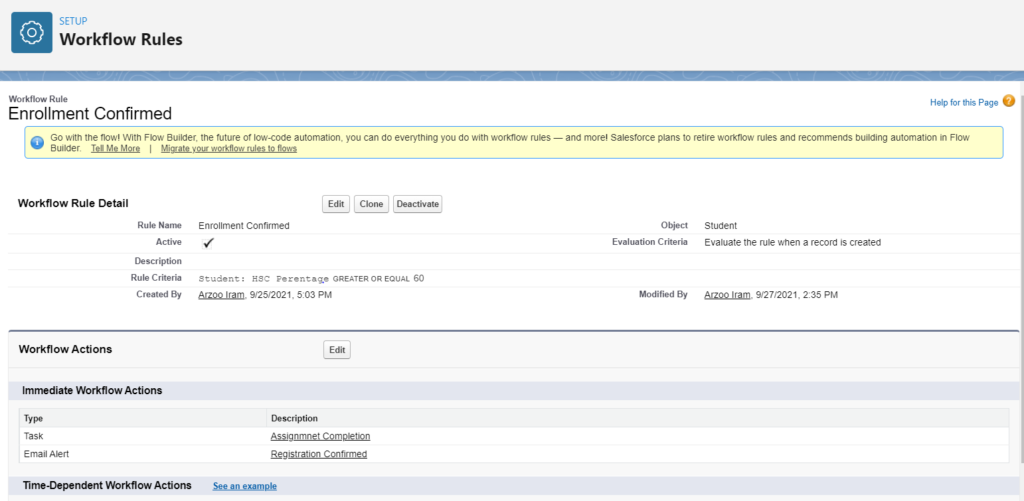The Difference Between Workflow, Process Builder, Flow

All of the mentioned tools come under automation tools in salesforce. Let’s understand the difference between all of them.
Workflow:
Workflow in Salesforce is a tool that automates certain actions based on particular criteria. If the criteria/conditions are met, the actions get executed. When criteria are not satisfied, records will get saved but no action will get evaluated.
Workflow is a container that consists of two components as follows:
1. Criteria: It contains the condition which if found correct /true then action will be executed.
2. Actions: It contains the actions that should be performed when the criteria are met.
Actions in workflow rules are of two types depending on when they are executed:
a) Immediate Actions (These actions are executed immediately when the criteria for a rule are met)
b) Time-Triggered Actions (These actions execute at a specific time that is specified when creating this type of action)
There are four types of actions that can be specified in a workflow rule:
- An Email Alert
- Field Update
- Tasks
- Outbound Messages

Advantages of Workflow:
- Workflow Rules are well known and widely used. It’s been around awhile and is dependable. It’s limited in functionality compared to other automation tools like Process Builder, it’s fast and easy to use and rarely breaks.
- Because of its simplicity, it’s a great initiator tool for a new Salesforce admin. The functionality is simple and there are scanty limits. This makes it ideal for a medium or large organization that needs to handle the amount of information.
Disadvantages of Workflow:
- If you’re awaiting advanced automation capability, you’ll need to look somewhere. Because Workflow Rules only evaluate one outcome, either the outcome is true and the action is executed, or the outcome is false and the action will not get executed.
- Workflow rules will only evaluate one output at a time, either it’s true and it will execute, or it’s false and it won’t execute. The fact that they are so simple can also be their collapse.
Process Builder:
Another automated tool or we can say a Process Builder is an extension of workflow with some additional features. This automation tool is easy to construct, has abundant functionality, and has increased the justifying work an admin can do. In Process Builder, you can create an entire process in one integrated place rather than creating various workflow rules.
It consists of various actions associated with it:
- Creating Records
- Updating Records
- Posting on Chatter
- Quick Action
- Launching or Triggering the Flow
- Submitting the Record Automatically for Approval
- Calling or Trigerring Apex Code
- Invoking Another Process
- Sending an Email Alert
With Process Builder, admins finally accessed the ability to demonstrate a proper order of operations/processes. Before Process Builder, admins were grappling with complex evasion just to be sure tasks occurred in logical order.
Also, Process Builder has versions, so you can hold on to deactivated Processes. This can be beneficial if you’ve realized something that is not working since you can recall seeing what was happening previously.
Advantages of Process Builder:
- Because of its enlarged list of features, Process Builder can do just about anything and everything. With many decision points, more than one output is possible. And Process Builder finally gives admins the ability to exhibit the proper order of operations within a process.
- Process Builder can merge numerous workflows into the unit process and can have a series of criteria.
- Child records can be updated in Process Builder.
Disadvantages of Process Builder:
- Created actions can not be re-used (except an email alert) and need to be re-examined for every criterion.
- You can not edit a process once it’s saved. For editing, you need to clone it first.
- Some standard fields (activity due date) for instance are still not able to be updated if they cannot be updated via standard workflow.
- It can not send outbound messages.
Flows:
To automate complex business processes Flow can be used in salesforce. It collects data and performed actions on the given data. It can be used to construct code-like logic without using any programming languages.
Flow can also be called Lightning Flow or Visual workflow. Flow can be used to update, edit, and create salesforce information and makes it available to the users. It can execute logic by interacting with the salesforce database and guide users through screens for collecting and updating information. Flow is more powerful than workflow rules and process builders. Workflow rules are always executed behind the scene, flows can provide screens to guide us through our business process. Flows aren’t bound to any one object. Flow can create, update, and delete records for multiple objects.
We can create various types of flows as per our business requirements. Flows can be classified into two main categories: a) Screen Flow b) Auto launched Flow
Screen Flow – It requires user interaction because it includes screens, local actions, series of steps, choices, or dynamic choices.
Auto launched Flow – It doesn’t require user interaction. Also doesn’t support screens, local actions, choices, or choice sets. It is used for complex business logic without writing a code.
Advantages Of Flows:
- Flow can do the things which Process Builder can’t. It is generally a lot more powerful and useful, not just in terms of special features, but in terms of the huge picture. It gives Admins access to “code-like” functionality, without having to write a single line code.
- This low-code or no-code, drag and drop feature of flow enables admin to reduce times for clients, digitize business workflows, and improve quality.
Disadvantages of Flow:
- Limitations are the same as process builder. There’s a large graph, so do not expect an easy-to-use wizard-style screen like the Process Builder. Again, processes can easily be broken.
Key Differences between Workflow, Process Builder, and Flow:
Workflow vs Process builder:
- Both process builder and workflow are automation tools that execute whenever the records get created or edited. But the difference is workflow is an old-school automation tool, process builder gives you a user-friendly visual representation of the process as you build it.
- you can do more with process builder as compared to workflows so in workflows we have four types of actions: Send an email, Field update, Task, Outbound message, and process builder we have 8 types of actions that are: Create a record, Update a record, Post something on to chatter, Launch a flow, Launch a quick action, Submit automatically for the approval, Call an apex code, Invoke another process.
- Outbound messages can not be sent using process builder for that you’ll have to go for the workflow rules.
- Process builder allows you to control the order of different actions like at which criteria which action gets executed and after that this criteria should be evaluated. You’ll be able to control the evaluation criteria of the processes using process builder which you’re not able to do with workflow. For example, if you created four workflow rules on a single object which one is gonna execute first and which gonna execute next you can’t predict that. But in process builder, we can decide the order of execution.
Process Builder vs Flow:
- Flow Builder can launch a chain of flows based on the results of the preceding one. Process Builder can trigger a flow, but it is less powerful and can’t launch a process depending on another process.
- Flow is faster than process builder.
- Flows are less time-consuming and very efficient than Process Builder (based on how you build logic) so it should be made allowance for if you are building multi-node process builders.


